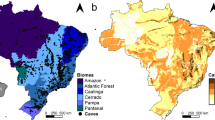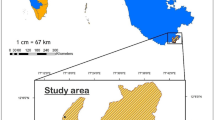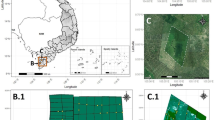Abstract
Surveillance on predatory mite fauna belonging to the suborders Mesostigmata and Prostigmata, covering three North Indian states Punjab, Himachal Pradesh and Rajasthan during 2019‒2021 recorded 14 species of predatory mites. Out of them 2 species of predatory mite belonging to family Balttisociidae, Lasioseius parberlesei and Lasioseius terrestris; 3 species to family Anystidae, Anystis baccarum, Tencat eiavillosa and Walzia darjeelingensis; 2 species to family Bdellidae, Bdella sp. and Bdellodes sp.; 1 species to family Cheyletidae, Cheletogenes ornatus; 1 species under family Cunaxidae, Cunaxa setirostris; 3 species of family Stigmaeidae, namely, Agistemus fleschneri, A. industani and Indostigmaeus rangatensis and 2 species of family Tydeidae, Pronematus fleschneri and Tydeus sp. were recorded. Out of these one species Tencat eia villosa has been recorded for the first time from India while Lasioseius parberlesei and L. terrestris; Indostigmaeus rangatensis and Pronematus flechneri have been recorded for the first time from the state of Punjab and North India.
Similar content being viewed by others
Data availability
The datasets used and /or analysed during the current study are available from the corresponding author on request.
Code availability
Not applicable.
References
Amrine JWJr, Manson DCM (1996) Preparation, mounting and descriptive study of Eriophyoid mites. In: Lindquist EE, Sabelis MW, Bruin J (eds) Eriophyoid Mites. Their Biology, Natural Enemies and Control. World Crop Pest, vol 6. Elsevier Science Publishers, Amsterdam, pp 383–396
Arbabi M, Singh J (2000) Studies on biological aspects of predacious mite Cunaxa setirostris on Tetranychus ludeni at laboratory condition in Varanasi, India. J Agric Rural Dev 20:13–23
Arbabi M, Singh J (2002) Studies on Agistemus industani Gonzalez-Rodriguez (Acarina: Stigmaeidae), an efficient predator of Tetranychus ludeni Zacker on mulberry. Acarina 10(1):85–89
Atwa WA, El-Naggar ME, Khalil AM, El-Shaer ME, Mostafa ZMM (2018) Biological studies on Cheyletid predator mite, Cheletogenes ornatus (Canestrini and Fanzago) when fed on the different preys. Egypt Acad J Biol Sci 11:21–29
Bala SC, Molla MIH, Debnath P, Ghosh SK (2019) Diversity of mite fauna associated with various agro-horticultural crops and forest plants in Orissa, India. J Entomol Zool Stud 7:846–851
Barbar Z (2016) The mite fauna (Acari) of two syrian citrus orchards, with notes on their morphology and economic importance. Syst Appl Acarol 21(8):991–1008
Bhattacharyya SK (1968) Studies on indian mites (Acarina: Mesostigmata) six records and descriptions of nine new species. Acarologia 10:52–549
Biswas S, Bhullar MB, Karmakar K, Kaur P (2022) Seven new records and distribution of phytoseiid (Acari: Mesostigmata) mite fauna associated with agri- horticultural crops in Northern India. Int J Trop Insect Sci 42:2425–2442. https://doi.org/10.1007/s42690-022-00770-1
Bjorson S (2008) Natural enemies of mass reared predatory mites (family: Phytoseiidae) used for biological control. Exp Appl Acarol 46:299–306
Chen X, Zhang Y, Ji J, Lin J (2007) Predation of Bdellodes japonicus (Ehara) on four species of spider mites (Acari: Bdellidae and Tetranychidae). Syst Appl Acarol 12(3):195–198. https://doi.org/10.11158/saa.12.3.3
Childers CC, Ueckermann EA (2020) The Tetranychoidea, Tarsonemidae and Tydeoidea mite complex on Florida citrus between 1954 and 2014: pests or beneficials? Syst Appl Acarol 25(7):1257–1278. https://doi.org/10.11158/saa.25.7.8
Childers CC, Villanueva R, Aguilar H (2001) Comparative residual toxicities of pesticides to the predator Agistemus industani (Acari: Stigmaeidae) on citrus in Florida. Exp Appl Acarol 25:461–474. https://doi.org/10.1023/A:1011805820546
Chow YS, Liu MA (1984) Preliminary studies on a parasite and a predatory mite of the tarsonemid mite Steneotarsonemus spinki Smiley. Acarology 6(1):323–327
Corpuz-Raros LA, Garcia RC, Navasero MM (2004) Mites (Acari) Associated with the culture of roses in the Philippines, including Leptocepheus rosaeus n. sp. (Oribatida: Otocepheidae) and three new species records. Asia Life Sci 13(1–2):1–40
Corpuz-Raros LA, Garcia RC, Navasero MM (2005) New host and geographic records of philippine plant mites (Acari), mainly on ornamental plants: I. Gamasida and Actinedida. Asia Life Sci 14(1):23–41
De Leon-Facudo JB, Corpus-Raros LA (2002) Two new species and a new record of predatory mites of the genus Lasioseius Berlese (Acari: Ascidae) inhabiting ornamental crops in the Philippines. Univ Philippines 85(1):39–46
Dhooria MS (1982) Natural enemy complex of Citrus mite Eutetranychus orientalis in Delhi, India. Acarol Newsl 11:6
Diraviam J, Selvanayagam M, Ignacimuthu S (2007) Record of Lasioseius parberlesei Bhattacharyya (Acari: Ascidae) on rice. Insect Environ 12(4):149–150
Ellingsen I-J (1971) Biology of Zetzellia mali (ewing) and Agistemus fleschneri Summer (Acarina: Stigmaeidae) related to their abilities to control the European Red-mite Panonychus ulmi Koch (acarina: Tetranychidae). Ohio State University
Fan Q-H, Flechtmann CH, Moraes GJDe (2016) Annotated catalogue of Stigmaeidae (Acari: Prostigmata), with a pictorial key to genera. Zootaxa 4176(1):1–199. https://doi.org/10.11646/zootaxa.4176.1
Gerson U, Smiley RL, Ochoa R (2003) Mites (Acari) for pest control. Blackwell Science, UK, p 539
Goldarazena A, Aguilar H, Kutuk H, Childers CC (2004) Biology of three species of Agistemus (Acari: Stigmaeidae): life table parameters using eggs of Panonychus citri or pollen of Malephora crocea as food. Exp Appl Acarol 32:281–291. https://doi.org/10.1023/B:APPA.0000023247.69450.dc
Greathead DJ, Greathead AH (1992) Biological control of insect pests by insect parasitoids and predators: the BIOCAT database. Biocont News Inform 13(4):61 N–68 N
Gupta SK (2002) A monograph on Plant inhabiting Predatory Mites of India. Part I. orders: Prostigmata, Astigmata and Cryptostigmata. Mem Zool Surv India 19:1–183
Gupta SK (2012) Handbook Injurious and Beneficial Mites Infesting Agro-Horticultural crops in India and their management. Published by Nature Books India, Kolkata, p 362
Gupta A, Chatterjee M (2004) Some new records of mites infesting stored grains in Kolkata and its neighbourhood. Rec. Zool Surv India 102(1–2):77–82
Gupta SK, Mitra S (2014) First report of mites (Acari) occurring on orchids and lichens in West Bengal, India. Rec Zool Surv India 114(4):525–528
Gupta A, Chattopadhyay M, Gupta SK (2014) On a collection of mites infesting herbs used as spices and oil seeds in India with special reference to western ghat areas. Rec Zool Surv India 114(2):251–262
Hassan M, El-Naggar M, Mesbah A, El-Nahas R (2014) Biological Aspects and Life Table Parameters of Cheletogenes ornatus (Canestrini & Fanzago) (Acari: Cheyletidae) when fed on different types of food. Acarines: J Egypt Soc Acarol 8(2):31–34. doi: https://doi.org/10.21608/ajesa.2014.163841
Heyer JD, Ueckermann EA, Khanjani M (2011) Iranian Cunaxidae (Acari: Prostigmata: Bdelloidea): part 2. Subfamily Cunaxinae. J Nat Hist 45:1667–1678. https://doi.org/10.1080/00222933.2011.559602
Hoy MA (2011) Agricultural Acarology: Introduction to Integrated Mite Management. CRC Press, p 430
Jayaram CS, Sharma PK, Sood AK (2019) Record of prostigmatid predatory mites from Himachal Pradesh. J Biol Control, 33(4): 348–352,2019, DOI: https://doi.org/10.18311/jbc/2019/23163
Jeppson LR, Keifer HH, Baker EW (1975) Mites injurious to economic plants. Univ Calif Press, pp 1–614
Kalmosh FSH, Yassin EMA (2018) Biodiversity of soil mites associated with wheat and soybean crops in Sharkeia and Beheira Governorates. Egypt J Agril Res 96(3):955–965
Khaustov AA (2020) Contribution to systematics of the family Cunaxidae (Acari: Bdelloidea) of western Siberia, Russia. Syst Appl Acarol 25(3):548–568. https://doi.org/10.11158/saa.25.3.14
Kielczewski B, Wisniewski J (1977) Irregularities in the guanine expel in the mite Cunaxa setirostris (Herm.) (Acarina: Cunaxidae). Acarologia 19(4):619–621
Menon MGR, Ghai S (1968) Further records of the distribution of Petrobia latens (Muller) (Acarina: Tetranychidae), a pest of wheat in India together with the description of a new species of predatory mites on the same. Ind J Entomol 30(1):77–79
Mesbah AE, Omar NA (2014) Predator-prey preferences and life-table-parameters of Cheletogenes ornatus (Canestrini & Fanzago) to red palm mite Raoeilla indica Hirst and date scale-insect Parlatoria blanchardii (Targ). Acarines 8:19–23
Meyer MKP, Ryke PAJ (1959) Cunaxoidea (Acarina: Prostigmata) occurring on plants in South Africa. Annal Mag Nat Hist 2(18):369–384. https://doi.org/10.1080/00222935908655745
Moraes GJDe, Abo-Shnaf RIA, Pérez-Madruga Y, Sánchez L, Karmakar K, Ho C-C (2015) The Lasioseius phytoseioides species group (Acari: Blattisociidae): new characterisation, description of a new species, complementary notes on seven described species and a taxonomic key for the group. Zootaxa 3980(1):1–41
Moraes GJDe, Neto RS, Pinto HCS (1989) Morphology, biology and pesticide tolerance of Chelotogenes ornatus (Acari: Cheyletidae). Entomophaga 34:477–484
Nachev P, Trenchev G (1987) Arcarofauna hosted by some Coccidae occurring in Bulgaria. Soil Science, Agrochemistry and Plant Protection. XXII(6):81–85 (in Bulgarian, with summary in English)
Navaei-Bonab R, Bagheri M, Zarei E (2012) Raphignathoid mite fauna of fields and orchards of Marand (Northwestern Iran) with two new records from Iran and six new records for East Azerbaijan province. Persian J Acarol 1(2):57–76
Negm MW (2014) Increasing knowledge of the mite fauna of the United Arab Emirates: new records and a checklist. Acarologia 54(1):113–120. https://doi.org/10.1051/acarologia/2014211
Omar NA, Mohamed OMO (2014) Effect of different prey mites on the biological aspects and life table parameters of the cunaxid mite, Cunaxa setirostris (Hermann) (Cunaxidae). Acarines 8(1):9–12
Prakash GK (2012) Mite fauna (Acari) associated with selected species of plants in Devarayanadurga area of Tumkur district. Environmental Science
Rehman MU, Kamran M, Alatawi FJ (2018) Genus Agistemus Summers (Acari: Trombidiformes: Stigmaeidae) from Saudi Arabia and a key to the world species. Syst Appl Acarol 23(6):1051–1072
Roy I, Gupta SK, Saha GK (2009) Predatory mites of the genus Agistemus (Acari: Stigmaeidae) from medicinal plants of West Bengal, India, with description of a new species. Entomon 34(3):175–180
Sadeghi H, Łaniecka I, Kaźmierski A (2012) Tydeoid mites (Acari: Triophtydeidae, Iolinidae, Tydeidae) of Razavi Khorasan province, Iran, with description of three new species. Ann Zool 62(1):99–114. https://doi.org/10.3161/000345412x633685
Salarzehi S, Hajizadeh J, Hakimitabar M, Ueckermann EA (2018) Contribution to the knowledge of cheyletid mites of Iran with redescription of Eucheyletia flabellifera (Michael, 1878) (Prostigmata: Cheyletidae). Acarologia 58(2):457–470. https://doi.org/10.24349/acarologia/20184253
Sathiamma B (1995) Biological suppression of the white spider mite Oligonychus iseilemae (Hirst) on coconut foliage. Entomon 20:237–243
Sharma A, Kushwaha KS (1983) Some plant mites of agricultural importance in Rajasthan. Abstract 2nd All India Symposium Acarology, Pune, pp1–19
Smiley RL (1992) The predatory mite family Cunaxide (Acari) of the world with a new classification. Indira Publishing House, West Bloomington, Michigan, p 356
Smith-Meyer MKP, Ueckermann EA (1987) A taxonomic study of some Anystidae (Acari: Prostigmata). Entomol Mem 68:1–37
Sorensen JT, Klnn DN, Dourr RL (1983) Biological observations on Bdella longicornis; a predatory mite in California vineyards (Acari: Bdellidae). Entomography 2:297–305
Tagore A, Putatunda BN (2003) Mites associated with some ornamental plants at Hisar, Haryana. Pest Manag Econ Zool 11:37–44
Thakur M, Dinabandhoo CL, Chauhan U (2010) Host range, distribution, and morphometrics of predatory mites associated with phytophagous mites of fruit crops in Himachal Pradesh, India. Trends in Acarology 431–434. https://doi.org/10.1007/978-90-481-9837-5_70
Tseng YH (1984) Mites associated with weeds, paddy rice, and upland rice fields in Taiwan. In: Griffiths DA and Bowman CE (eds). Acarology VI, Vol. 2, Ellis Horwood Limited, Chichester, UK, pp. 770–780
Tseng YH (1989) Taxonomical studies on mites associated with weeds, paddy rice and upland rice fields in Taiwan (I). Chin J Entomol 3:1–35
Wallace MMH, Walters MC (1974) The introduction of Bdellodes lapidaria (Acari: Bdellidae) from Australia into South Africa for the Biological Control of Sminthurus viridis (Collembola). Australia J Zool 22:505–517. https://doi.org/10.1071/ZO9740505
Zaher MA, Yousef AETA, Kandil MM (1982) Effect of food on the biology of Cheletogenes ornatus (C. & F.) (Acari: Prostigmata: Cheyletidae). Acarologia 22(4):361–366
Acknowledgements
The authors acknowledge the Head, Department of Entomology, Punjab Agricultural University, Ludhiana, Punjab, India for providing necessary support in the form of laboratory and field facilities to carry out our research work. The First Author (Shubhadeep Biswas) is also grateful to Indian Council of Agricultural Research, New Delhi, for the grant of ICAR-PG Scholarship (No. F1-EDN/1/25/2015-Exam cell and order no. Ag.edn. 2(9)/2018-HRD for a period of two years during his M.Sc. programme. The second and third authors are grateful to the Indian Council of Agricultural Research for financial grant and infrastructural facilities under the All India Network Project (AINP) on Agricultural Acarology. The authors also acknowledge the facilities used under the Fund for Improvement of S&T infrastructure in universities and higher educational institutions (DST-FIST) project (project no SR/FST/LSI/636/2015(c).
Author information
Authors and Affiliations
Contributions
SB and MBB conducted the surveys and collected the specimens of different mite species; SB illustrated, wrote the results and the manuscript ; MBB conceived the idea, identified the species and reviewed the manuscript and conducted the overall management of the article. PK helped in data collection and preparation of the article. All authors read and approved the final manuscript.
Corresponding author
Ethics declarations
Conflicts of interest/Competing interests
The authors declare that they have no competing interests.
Ethics approval
Not applicable.
Consent to participate
Not applicable.
Consent for publication
Not applicable.
Additional information
Publisher’s note
Springer Nature remains neutral with regard to jurisdictional claims in published maps and institutional affiliations.
Rights and permissions
Springer Nature or its licensor (e.g. a society or other partner) holds exclusive rights to this article under a publishing agreement with the author(s) or other rightsholder(s); author self-archiving of the accepted manuscript version of this article is solely governed by the terms of such publishing agreement and applicable law.
About this article
Cite this article
Biswas, S., Bhullar, M.B. & Kaur, P. Five new records and distribution of predatory mite fauna (Arachnida: Acari) associated with crop ecosystems of northern India. Int J Trop Insect Sci 43, 1305–1315 (2023). https://doi.org/10.1007/s42690-023-01040-4
Received:
Accepted:
Published:
Issue Date:
DOI: https://doi.org/10.1007/s42690-023-01040-4




